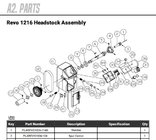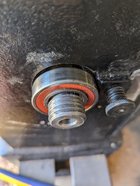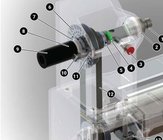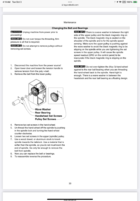-
December 2025 Turning Challenge: Single Tree! (click here for details) -
Congratulations to Bob Henrickson, People's Choice in the November 2025 Turning Challenge (click here for details) -
Congratulations to Guillaume Fontaine for "Old Tea Pot" being selected as Turning of the Week for December 15, 2025 (click here for details) -
Welcome new registering member. Your username must be your real First and Last name (for example: John Doe). "Screen names" and "handles" are not allowed and your registration will be deleted if you don't use your real name. Also, do not use all caps nor all lower case.
You are using an out of date browser. It may not display this or other websites correctly.
You should upgrade or use an alternative browser.
You should upgrade or use an alternative browser.
Loose Bearings
- Thread starter Charles Cadenhead
- Start date
Appropriate sized socket and a hammer. Or If you can lock the spindle screw the chuck on with a bar between the jaws to give leverage.
Those are great ideas, thanks!Appropriate sized socket and a hammer. Or If you can lock the spindle screw the chuck on with a bar between the jaws to give leverage.
Michael, I was able to use a faceplate to reseat it. The faceplate was threaded the whole length of it's shaft so I was able to just keep screwing until the bearings were in position. Thanks for the suggestion!Appropriate sized socket and a hammer. Or If you can lock the spindle screw the chuck on with a bar between the jaws to give leverage.
Is the bearing out on both inner and outer diameters or only inner or only outer? If the shaft is in the correct axial position then both races are out. (Look at the other end of the shaft. A bearing is normally set as a press fit on the shaft and a very close fit in the outer diameter. This rule is subject to change due to other design considerations. If inner race only or even both use small washers (less then small dia. of outer race) and a nut on the shaft. The outer race should be guided carefully in place.
If both bearing are out look at the manual.
If both bearing are out look at the manual.
If it comes out again put some Loctite bearing retainer on it. The downside is you will have to use heat to remove the bearing if it ever goes bad.
I don't understand what happened here. You were running the lathe and the bearing at the rear or outboard end of the spindle somehow moved out of the headstock casting? Wasn't there a bearing retaining nut on the threaded rear portion of the spindle? What happened to that nut?
No nut, there is a spindle handwheel I guess that suppose to replace a retaining nut. I had removed the handwheel to do some outboard turning but haven't replaced it yet. I'm assuming centrifugal forcing on the spindle moved it out. It was easy to slide back into position.I don't understand what happened here. You were running the lathe and the bearing at the rear or outboard end of the spindle somehow moved out of the headstock casting? Wasn't there a bearing retaining nut on the threaded rear portion of the spindle? What happened to that nut?
Attachments
The question was how to get the bearing back in- but it also begs the other question-how did it come out. Bearings should be a tight /interference fit in the housing. The hand wheel should not act as a retainer. So a means of locking it in is required as mentioned
I didn't see any kind of locking mechanism and I didn't see one in the lathe manual. The picture I included is from the manual. The YouTube videos I watched (owners changing out their bearings) were just popping them in and out. Though it does seem like the fit should be tighter. Here's another picture from the manual. #15 is the rear bearing and 17 is the handwheel.The question was how to get the bearing back in- but it also begs the other question-how did it come out. Bearings should be a tight /interference fit in the housing. The hand wheel should not act as a retainer. So a means of locking it in is required as mentioned

I question the interference fit in the housing. The chance of cracking the casting plus the load it puts on the bearing to chance the clearance between the race and the rollers or balls can shorten the life.Bearings should be a tight /interference fit in the housing.
From a practical viewpoint- with the hand wheel on, the bearing can’t come fully out. Tight fit or I’d be putting a smear of epoxy on that outer face as it is pushed/slid home. After all, you are simply trying to get the shaft to rotate within the bearing. Ideally the shaft should not rotate within the inner and the outer should be firm within the casing but for hobby use it will be fine as it is.
Generally a nut (or possibly the hand wheel in your case) acts to retain the bearing onto the spindle. The nut or hand wheel could also be an adjustable pre-load on the bearings. The design also might allow the bearing to have just a bit of "float" in the casting to account for normal expansion of the spindle/headstock due to warming up in use.
Adjusting bearing pre-load can be important, too tight and the bearings will overheat and wear excessively , too loose and the bearings will wear and the spindle will have too much play. Play which could affect accuracy is not particularly important on a wood lathe.
Adjusting bearing pre-load can be important, too tight and the bearings will overheat and wear excessively , too loose and the bearings will wear and the spindle will have too much play. Play which could affect accuracy is not particularly important on a wood lathe.
- Joined
- Apr 27, 2004
- Messages
- 9,306
- Likes
- 6,062
- Location
- Lakeland, Florida
- Website
- www.hockenberywoodturning.com
Reading the manual has removed all of excitement from this discussion.



